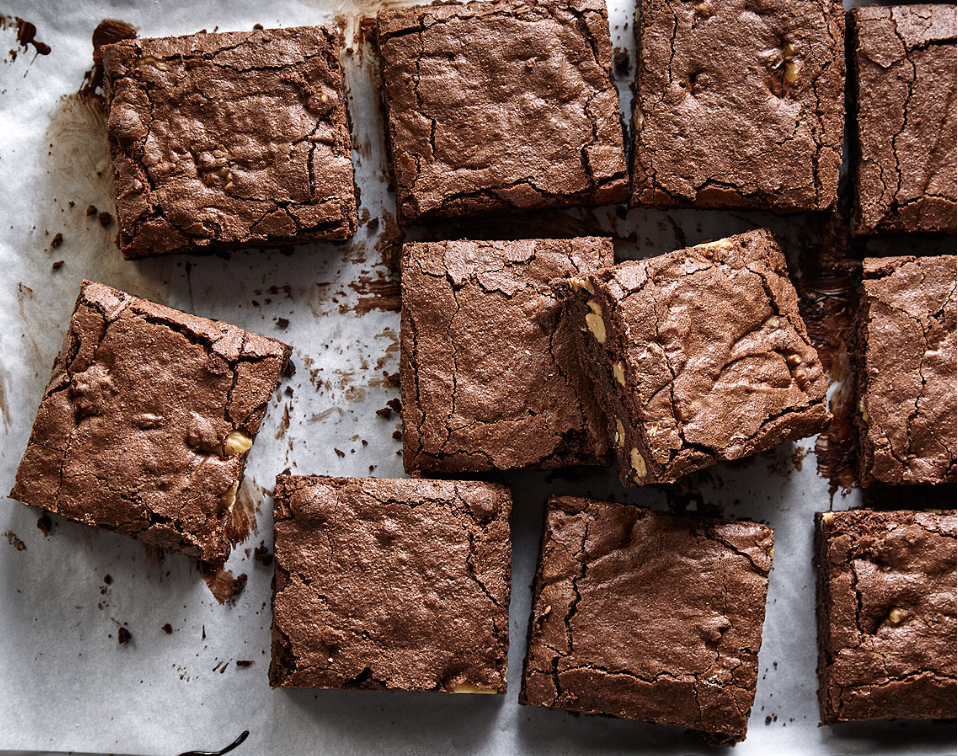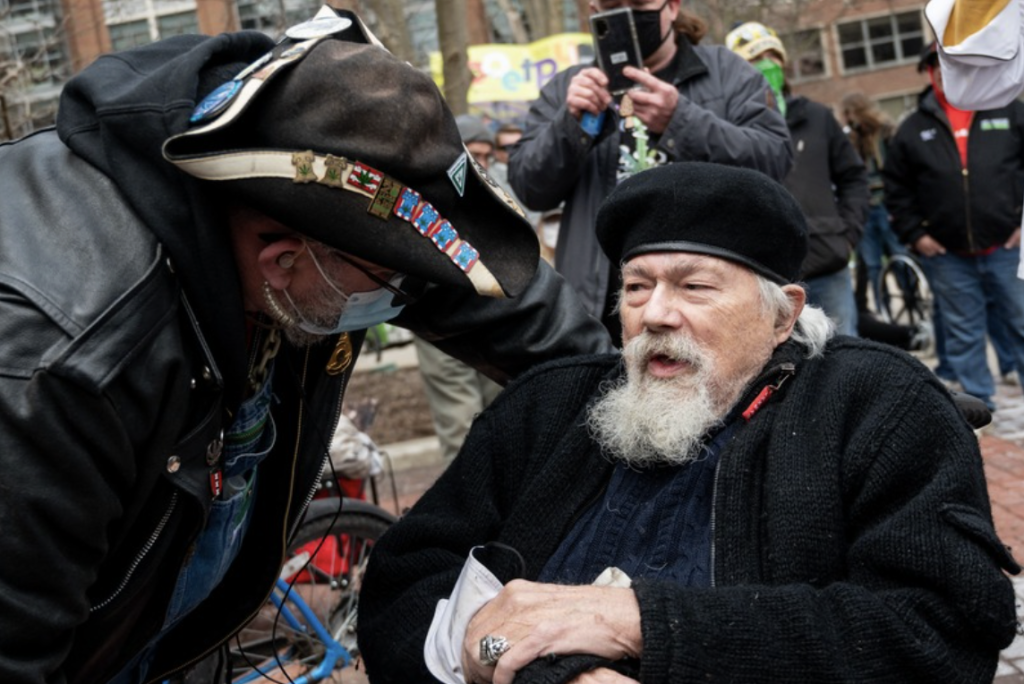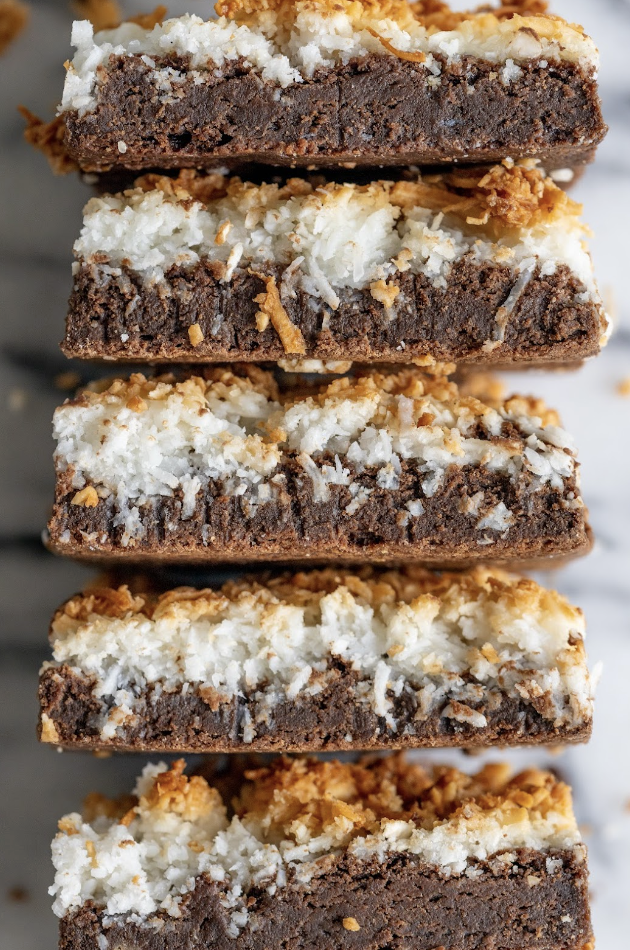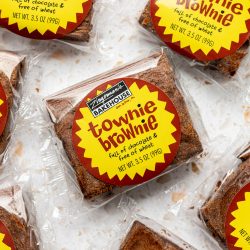
Magic Brownies and the month of April go hand in hand as we mark two annual April celebrations – 4/20 and the Ann Arbor Hash Bash that unfolds on the University of Michigan campus early in the month. These two festive events are examples of holiday celebrations totally disconnected from the seasons, religions, or the passage of time. Rather, they show that political events and activism are yet another source of days people like to mark and celebrate.
Our Magic Brownies are large, wallet-sized, full-flavored, dark chocolate squares studded with toasted walnuts. They’ve been an iconic part of the Zingerman’s experience now for over three decades. They were first made at the Deli, but taken over by the Bakehouse in 1994, two years after we opened. We dubbed them “Magic Brownies”. Their name is a cheeky nod to Ann Arbor’s well-known marijuana-friendly culture and activism. Every year since 1972, Ann Arbor has been celebrating all things “weed” on the first Saturday in April with its Hash Bash on the University of Michigan campus. And it should come as no surprise that this annual Tree Town bash happens to coincide with 4/20 or “Weed Day”. This marijuana counterculture holiday is observed yearly worldwide on, you guessed it, April 20th.
A Brief History of 4/20
4/20 and the Ann Arbor Hash Bash festivals both have roots in the marijuana counterculture of the 1970s. Back then, especially here in the US, marijuana became a potent symbol of peace, freedom, and social change. At the same time, an activist movement began to mobilize around liberating and legalizing the beloved drug for both medicinal and recreational use.

April 20th or 4/20 has long been an unofficial day of celebration for marijuana enthusiasts and activists alike. It’s an occasion to gather for campus smoke-outs, concerts, marijuana festivals, and rallies advocating legalization.
The “High Holiday,” with its distinctive 4/20 designation, seems to have originated in 1971 with a group of high school students in Marin County, California, just north of San Francisco. Calling themselves the “Waldos”—a reference to the teenagers’ favorite hangout spot along a wall outside their high school—the group began meeting every day at 4:20 pm to smoke marijuana and then proceeded to conjure up ever-more-interesting things to do while under the influence, dubbing their adventurous shenanigans, “safaris.” It was not long before this late afternoon ritual spread across the country and 420 became code for smoking marijuana. Eventually, 420 morphed into 4/20 for calendar purposes, and the unofficial national day of marijuana celebration and activism was born.
The beginnings of Hash Bash
Just as the notion of 4/20 was getting off the ground in Northern California, Ann Arbor held its inaugural Hash Bash on the University of Michigan’s Central Campus on Saturday, April 1, 1972. Originally, the celebration was a victorious response to the Michigan Supreme Court’s March 9, 1972 decision declaring unconstitutional the law that had landed John Sinclair, the poet and cultural activist from Flint, Michigan, in prison for marijuana possession. Arrested and convicted in 1969 for possession of two joints, Sinclair had been serving a 10-year sentence when in 1972 his conviction was overturned and he was released from prison.
The Court’s decision also left the State of Michigan without a law prohibiting the use of marijuana. This opened the door and set the stage for the inaugural Hash Bash. That same year, and again in 1974, the City of Ann Arbor proceeded to enact some of the most lenient laws on marijuana possession in the US, making small amounts of the drug only a civic infraction subject to a small fine.

In the 50 years since, organizers have structured Hash Bash around efforts to legalize marijuana. Yet, it has also grown into a joyous festival tradition. Early in April, usually the first Saturday of the month, thousands of Michigan students join the left-wing hippy and marijuana activist community of Ann Arbor to celebrate all things weed. Crowds gather on “The Diag,” the large open space on the university’s Central Campus. Many come decked out in tie-dye garb and carrying “Legalize Mary Jane” banners. Prominent on the festival roster are speeches by activists, musicians, writers, celebrities, and even politicians advocating legalization. There’s also live music, street vending, and occasional civil disobedience.
Hash Bash today
Now that marijuana is fully legal in Michigan, with medicinal use being legalized in 2009 and recreational use following in 2018, activists have refocused their legalization campaign on the federal government. Their quest now is to legalize weed across the country with sweeping federal legislation. Still, many folks come purely to Hash Bash to celebrate and indulge freely, whether smoking or ingesting. “Magic brownies”, other baked goods, and candy permeate the festival each year.

This year’s Hash Bash on Saturday, April 6th was especially poignant. It turned reverent as the crowd gathered on The Diag paid tribute to the life and legacy of John Sinclair. The influential marijuana activist was the inspiration for and prominent supporter of the Hash Bash. He died on April 2, 2024, at 82, just days before his scheduled appearance at this year’s festival. For more on John Sinclair’s life and legacy, head here.
The Evolution of Our Magic Brownie!


One interesting thing about being a bakery since 1992 is participating in the evolution of food, even seemingly “finished” food like the American brownie. Much has happened to our original Magic Brownie! What began as a full-flavored, walnut-studded, dark chocolate brownie has now evolved into four different variations–Magic (the original with walnuts), Black Magic (no nuts), Buenos Aires (Black Magic filled with dulce de leche), and Black & White (Black Magic layered with vanilla coconut macaroon). And in our never-ending quest to make our food more deeply flavorful, we now make all of our Magic Brownie variations with better chocolate, better baking methods, and with regional organic, soft white, whole wheat pastry flour, stone-milled and finely sifted to an 80% extraction by our friends at Janie’s Mill in Ashkum, Illinois. We love the enhanced flavor and improved nutrition all these fine ingredients bring to the Magic Brownie mix. Yes! You really can taste the difference!
And what’s even more surprising? Magic Brownies have been around long enough that it’s now actually legal in Ann Arbor and the state of Michigan to make and sell truly “magic”—that is, marijuana—brownies! Who woulda thought? And with new and well-established marijuana dispensaries in town getting into the “magic brownie” baking game, we just might have to change the name of ours or risk being charged with false advertising!
Hungry for more?
- Order our Magic Brownies for local pickup
- Order our Magic Brownies and ship them nationwide
- Get the recipes for our Magic, Black Magic, and Buenos Aires Brownies in our first cookbook Zingerman’s Bakehouse
- Get the recipe for our Black & White Magic Brownie in our newest cookbook, Celebrate Everyday
- Sign up for our hands-on Zingerman’s Classics BAKE! class and learn how to make our Black Magic Brownies
After a long, established career as a Ph.D. art history scholar and art museum curator, Lee, a Michigan native, came to the Bakehouse in 2017 eager to pursue her passion for artisanal baking and to apply her love of history, research, writing, and editing in a new exciting arena. Her first turn at the Bakehouse was as a day pastry baker. She then moved on to retail sales in the Bakeshop, followed by joining the Marketing Team and becoming the Bakehouse’s designated culinary historian. In addition to her retail sales and marketing work, she’s a member of the Bakehouse’s Grain Commission, co-author and editor of the Bakehouse's series of cookbooklets, and a regular contributor to the BAKE! Blog and Zingerman’s Newsletter, where she explores the culinary, cultural, and social history and evolution of the Bakehouse’s artisan baked goods.

